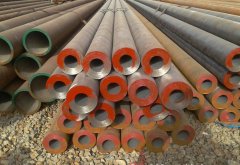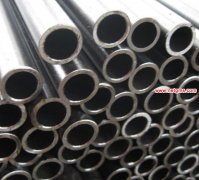Specifications: diameter: 320 to 127 mm thickness: 0.4 to 12.7 mm Length: 6 m above, and, in accordance with customer demand, supply and other specifications of steel pipe
Pipes Catalog
 Seamless steel pipe
Seamless steel pipe- pipeline
- OCTG
- ASTM pipe
- API pipe
- Heavy Wall Steel Pipe
- Boiler steel pipes
- Casing and tubing
 Welded steel pipe
Welded steel pipe- spiral steel pipe
- ERW pipe
- SSAW pipe
- DSAW pipe
- LSAW pipe
 Carbon steel pipe
Carbon steel pipe- Black steel pipe
- fluid pipe
- Pipeline Coating,2PE 3PE
- Structural steel pipe
- Mild Steel Pipe
 Alloy pipe
Alloy pipe galvanized steel pipe
galvanized steel pipe stainless steel pipe
stainless steel pipe steel pipe schedule
steel pipe schedule pipe fittings
pipe fittings
decisive parameter for the selection of API 5L steel pipeline for service in a hydrogen environment.
Steel welds representing 3 generations of pipeline carbon steel have been studied towards hydrogen result, making use of the fracture toughness parameter J integral that is a measure in the plastic do the job. The influence of hydrogen on the growth of a partial wall defect is studied and comparisons using the growth in the exact same defect in air are presented. The tests carried out had been three-point bending fracture toughness exams, in air and in a hydrogen natural environment simulated by electrolysis. Reduction in J0 was observed in all pipeline steel grades since the present density increases, which was much more pronounced in the base metal rather then within the heat affected zone. The various microstructures from the welded steels are observed and correlated for the reduction in plasticity. It is actually concluded that microstructure appears to be the decisive parameter for that collection of a pipeline steel for service in a hydrogen environment.
toughness remains large, the place most values are close to a hundred MPa?m1/2. Hydrogen has a much more
pronounced result on crack propagation resistance; dJ/da values measured in hydrogen gasoline can
be 90% lower than values measured in air or inert gasoline.
The fracture toughness measured in hydrogen gasoline is delicate to each the loading charge and gas
strain. Figure three.two.1.one exhibits the fracture toughness for X42 steel in 4 MPa hydrogen gas is
consistent at displacement charges from 3x10-5 to 3x10-4 mm/s but then increases by 30% as the
displacement charge increases to 3x10-3 mm/s [11]. Figure 3.two.one.2 displays the fracture toughness vs
hydrogen gasoline stress data for X42 and A516 steel from Table 3.2.1.1 [8, 9, 11]. For both sets of
data, fracture toughness decreases as gasoline pressure increases but seems to be approaching a
reduced limiting value. Fracture toughness values are greater for A516 in comparison to X42, but this
difference may well be due in portion on the higher loading charge for exams on A516.
Fracture toughness can rely sensitively on gasoline composition, as illustrated in Figure three.two.1.3
[6]. In this figure, fracture toughness measurements are shown for X42 and X70 steels in
nitrogen, methane, and hydrogen, too as mixtures of hydrogen, methane, carbon monoxide,
and carbon dioxide. The results for hydrogen and nitrogen are the similar data from Table three.two.one.1.
The data in Figure 3.2.one.3 display that methane does not adversely have an effect on fracture toughness,
having said that a mixture of methane and hydrogen leads to a reduction in fracture toughness.
Moreover, fracture toughness will not be degraded in gas mixtures containing hydrogen and carbon
monoxide. In these circumstances, carbon monoxide hinders hydrogen uptake in to the steel and precludes
hydrogen-assisted fracture [6], no less than about the time scale of your fracture toughness test.
上一篇:contactSS
Copyright (c)2012 LongtaidiIf you do not find the information you need, Click
Here Get Support
New Update Pipe List
-
API 5L Line Pipes X42
API 5L Line Pipes X42,API 5L: A25, A, B, X42, X46, X52, X56, X60, X65, X70, X80 API 5CT: J55 K 55 M65 N80 L 80 C 90 T 95 P110 H40 Q125 CS-90 SCS-95 SCS-80 TCS-110T . API 5l A53 ERW Pipe
API 5l A53 ERW Pipe,ERW steel pipe JCEO Wall thickness:0.5mm-25 ISO,TUV,AD,PED cert. GB/T3091-2001 Material include Q235 20# 16Mn(Q345,Q215) . Hot rolled seamless steel pipe production
Hot rolled seamless steel pipe production. Water line pipe
Water line pipe Size:4" to 60" carbon steel seamless pipeline, piplines,ERW line pipes,Spiral pipes.SSAW COATING PIPE LINE : [ Spiral Submerged Arc Welding (SAWH) steel pipeline].
Hot Click PRO
-
A53 SCH40 Welded Carbon Steel Pipe
A53 SCH40 Welded Carbon Steel Pipe, Grade: A53 GR. B, API 5L GRB, API 5CT GR. B, ST37, ST52 Outside Diameter: 1/2"-72" Wall Thinkness: 0.5mm-80mm sch40--schXXS.. ASTM A106/A53 GR.B 32 INCH Carbon Seamless pipe
1. Carbon Seamless Steel Pipes of API 5L/ ASTM A106/A53 GR.B.2. Hot Expanded Seamless Steel Pipes.3. ERW Steel Pipe.. Thin-walled steel material parameters Reverse
Thin-walled steel material parameters Reverse,Advanced design and manufacture of the State Key Laboratory of auto body Hunan University, Changsha, 4100822. Abstract: identify the problem for thin-walled steel material parameters, using a. ANSI steel pipe schedule chart - SCH40 SCH80 seamless ERW pi
ANSI steel pipe schedule chart - SCH40 SCH80 seamless ERW pipe .
- Carbon steel pipe Standard
- ASTM A106 pipe
- ASTM A53 pipe
- ASTM A192 pipe
- ASTM A252 pipe
- ASTM A179 pipe
- DIN 1629 pipe
- DIN 17175 pipe
- Alloy pipe Standard
- ASTM A335 pipe
- ASTM A210 pipe
- ASTM A213 pipe
- ASTM A234 pipe
- ASTM A519 pipe
- Stainless pipe metrial
- 304, 304L, 304SS pipe
- 310, 310S pipe
- 316, 316L pipe
- Pipe Fitting Metrial
- Carbon steel: A234 WPB pipe
- Stainless steel: 304,316 pipe
- Alloy steel: A234 WP5 WP9 WP11 WP22 pipe











